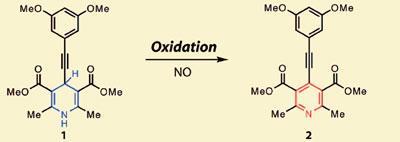A jelly-like substrate is being used to detect nitric oxide in exhaled breath, a telltale sign of diseases like tuberculosis and lung cancer
Nina Notman/Salt Lake City, US
A device that uses a jelly-like substance to detect nitric oxide in exhaled breath - an indicator of lung diseases such as tuberculosis and lung cancer - is being developed by scientists in the US.
Substances capable of forming gels - gelators - are widely studied, but the fundamental science of gelation is still poorly understood. To help fill this knowledge gap, Anne McNeil and her team from the University of Michigan, Ann Arbor, US, have been exploring the use of analytes - such as nitric oxide (NO) - to trigger the gelation of small molecules.
’We are using analytes to induce a structural change in small non-planar molecules,’ explains group member Jing Chen, who presented the work at the American Chemical Society’s Spring meeting in Salt Lake City. This structural change causes the molecules to become planar, allowing them to pack tightly together to form the gel.
’Gels are similar to jelly, as they are not a solid and not a liquid, but a phase in between the two,’ explains McNeil. ’They have similar physical properties - you can deform them and they will bounce back and they will support their own weight if you turn them upside down.’
Stimulus-induced gelators are particularly difficult to design as the precursor molecule must not form a gel, explains Chen. In the case of the NO sensor, the team have designed a precursor based on a non-planar dihydropyridine. When exposed to NO, in the presence of oxygen, the dihydropyridine ring is oxidised - to a planar pyridine ring. The planar molecules can pack much more closely, and pi-pi interactions can form between the electron rich group (the benzene ring and triple bond) and the electron poor group (the pyridine ring) in different molecules, creating a gel.

Elevated levels of NO in exhaled breath is a biomarker for pulmonary diseases such as lung cancer and tuberculosis, and there has been much into using breath tests as a diagnostic tool using chemiluminescence, says Chen. There are problems with these devices, however: ’It takes a long time to prepare the sample, the instrument is pretty expensive and you need a technician to interpret the data,’ she explains. Her team have been using their gelation experience to devise a sensor that provides a simple visible output - switching from a liquid to a gel - if NO is breathed into it.
’The sensitivity of our system is 0.1 part per thousand, which is about 1000 times less sensitive than we need it to be,’ explains Chen. ’We are working on improving this, and have some preliminary results that show adding a polymer increases the sensitivity,’ she says. ’We are looking at the interaction of polymers with the molecular gels, and we found that some polymers make the gels form at lower concentrations of NO, so it makes the system more sensitive,’ adds McNeil.
Tim Swager, an expert in chemosensors at the Massachusetts Institute of Technology, Cambridge, US, says that it’s ’a cool reaction’. ’To my knowledge this is very new as a way to detect NO, I’m not aware of anybody using this small-molecule triggered gelation to do this. But the gelation is not the only thing that is neat about this paper. It’s the fact that she triggered a very large structural change in the molecule - that’s also nifty,’ he adds.
As well as developing sensors, the team’s ultimate goal is to better understand the rules governing gel formation. ’We have recently started studying the structure-property relationships in gelators,’ says Chen. ’We can hopefully come up with ideas of what structures will most likely lead to a gelator, so that in the future we can design a gelator rather than just finding one,’ she adds.
As the first step towards this blueprint for designing gelators, Chen has been looking at the effect a slight change to the structure of the molecules used in the NO sensor has on its gelation properties. So far, explains McNeil, changing the substituents on the pyridine and the benzene ring, and also changing the triple bond to a double bond, have been examined. ’What we have learned so far it that is not obvious what is going to disrupt gelation,’ she says.
References
J Chen and A McNeil, J. Am. Chem. Soc., 2008. DOI: 10.1021/ja807651a






No comments yet